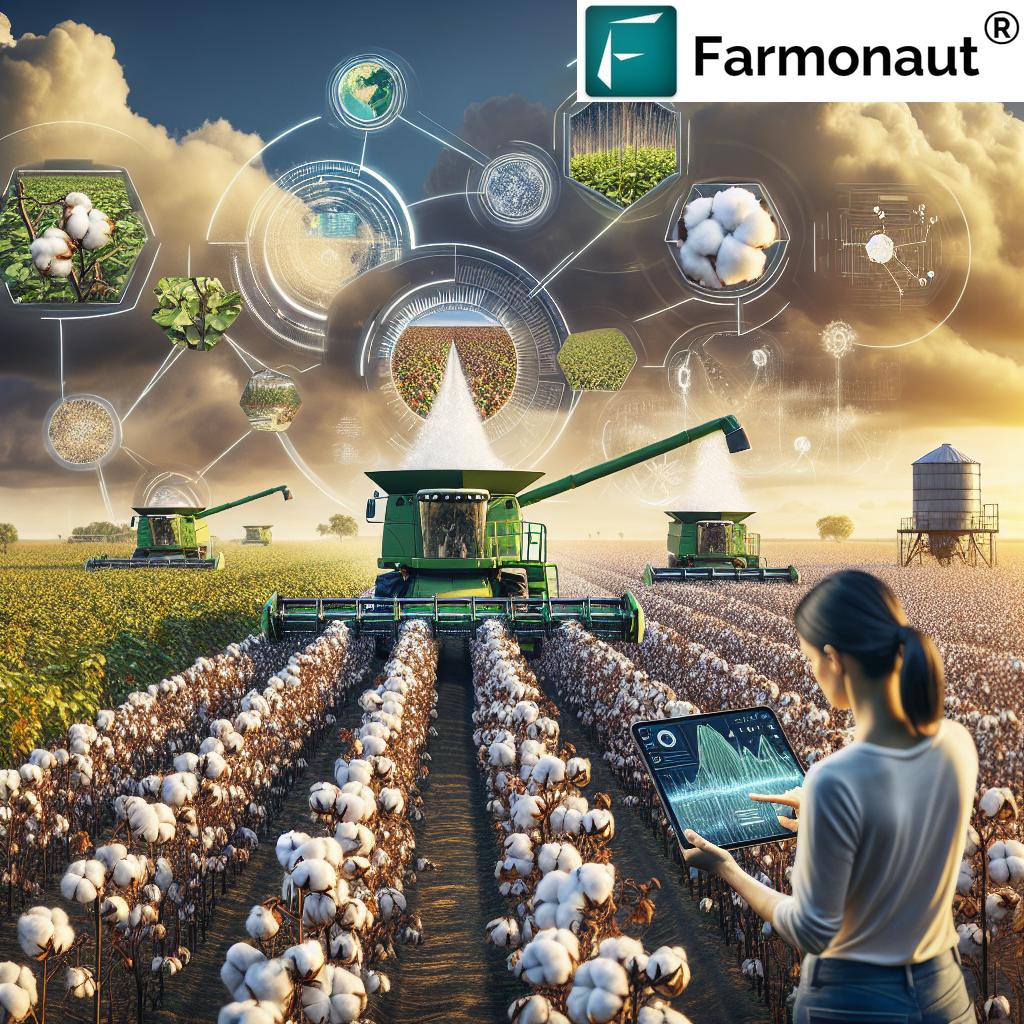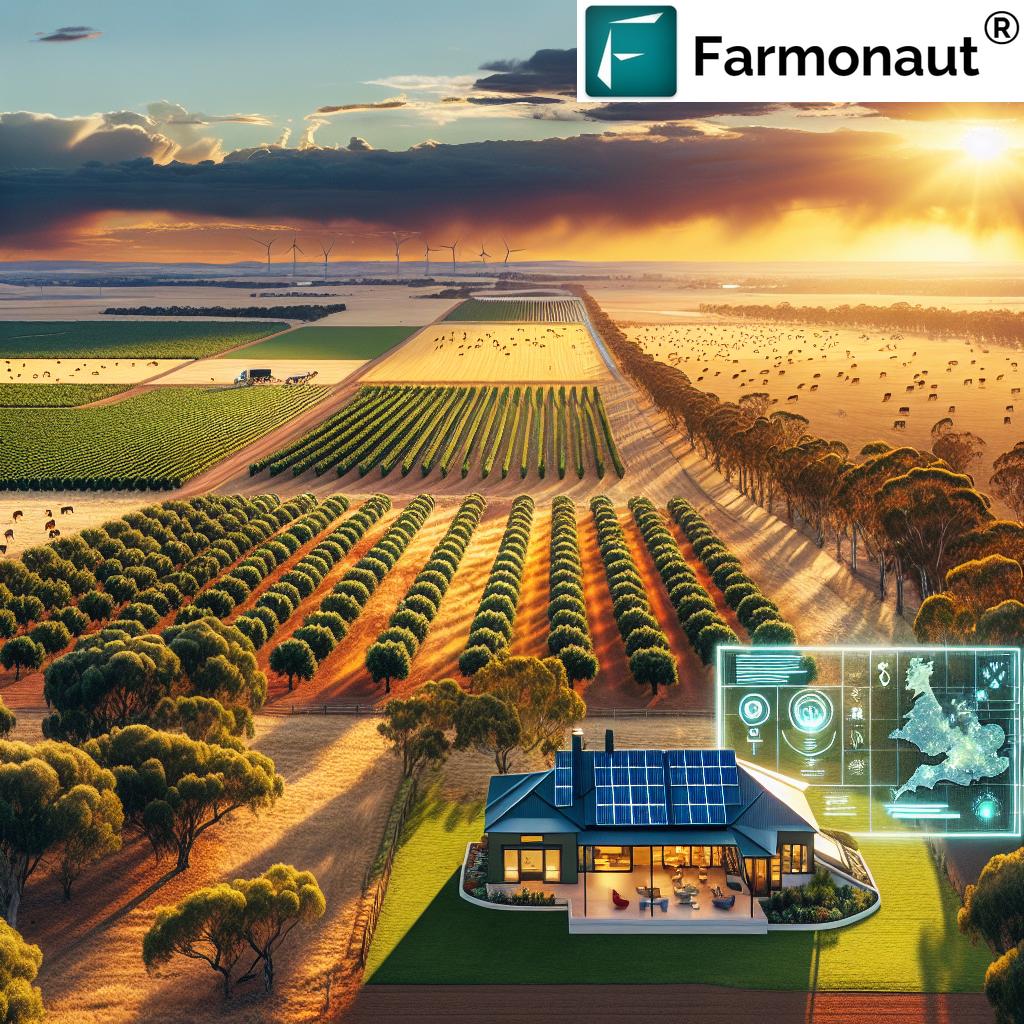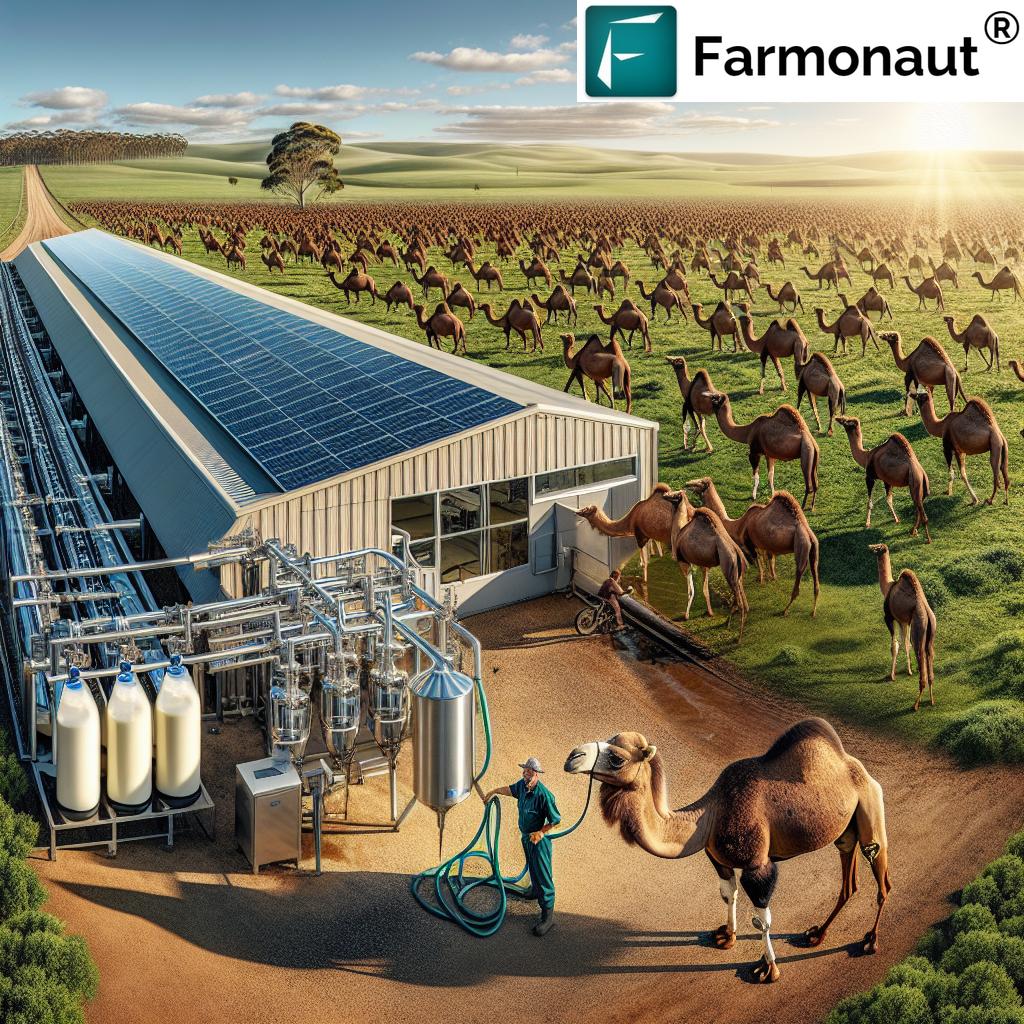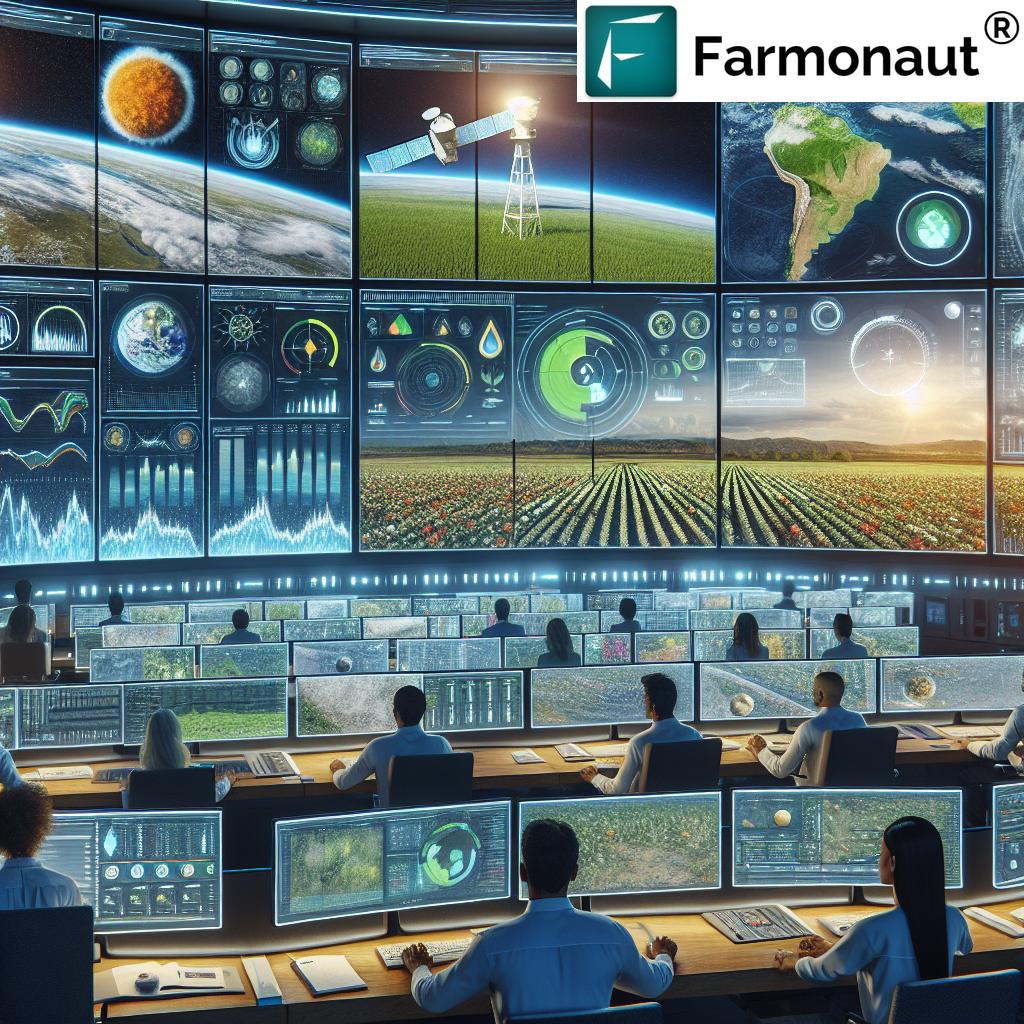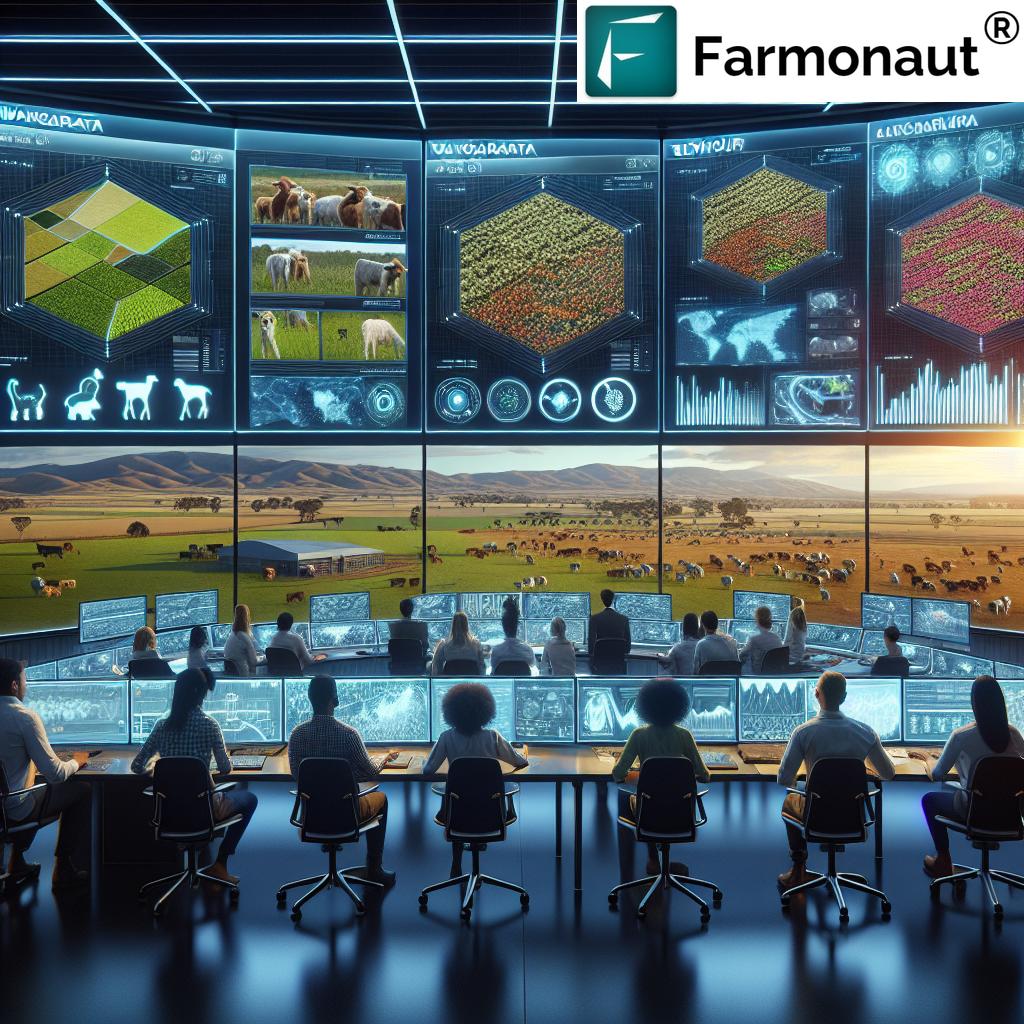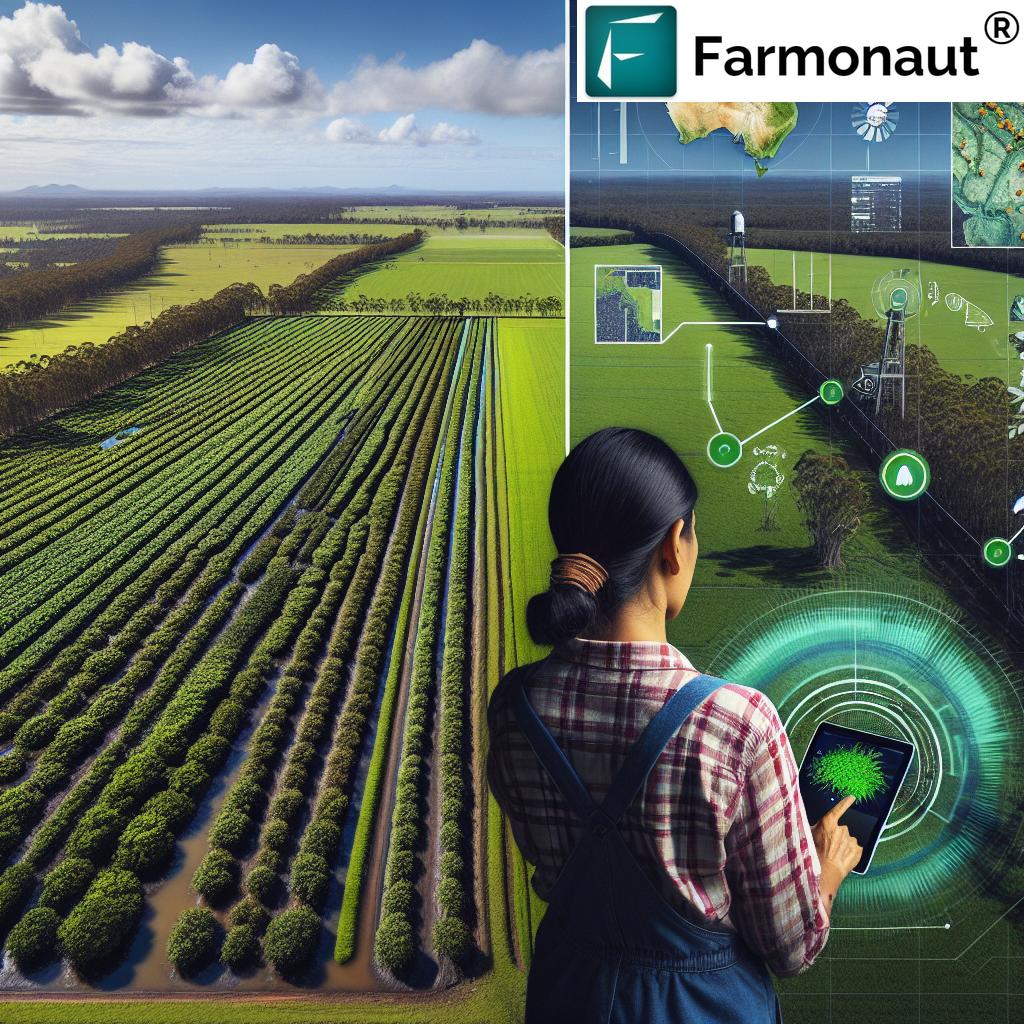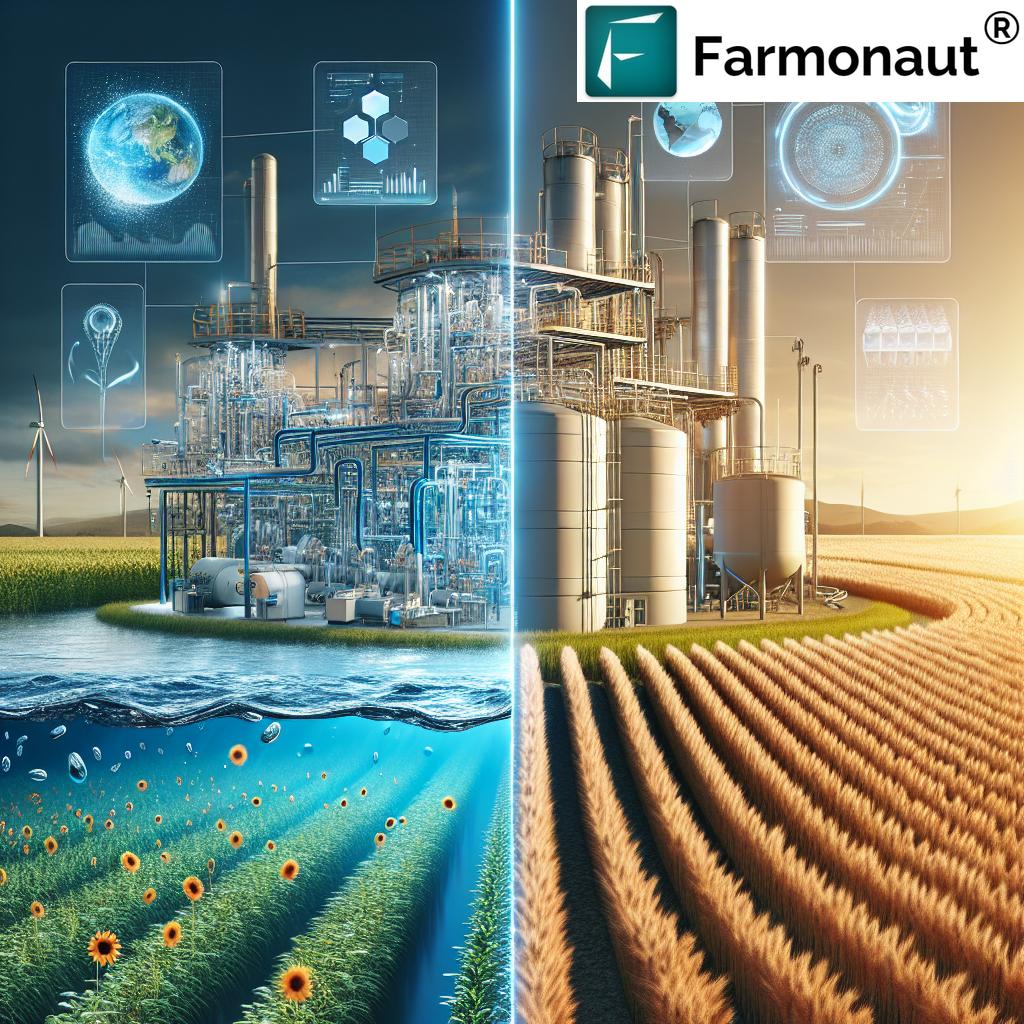Sustainable Farming Practices: Farmonaut’s Precision Agriculture Technology for Queensland’s Future
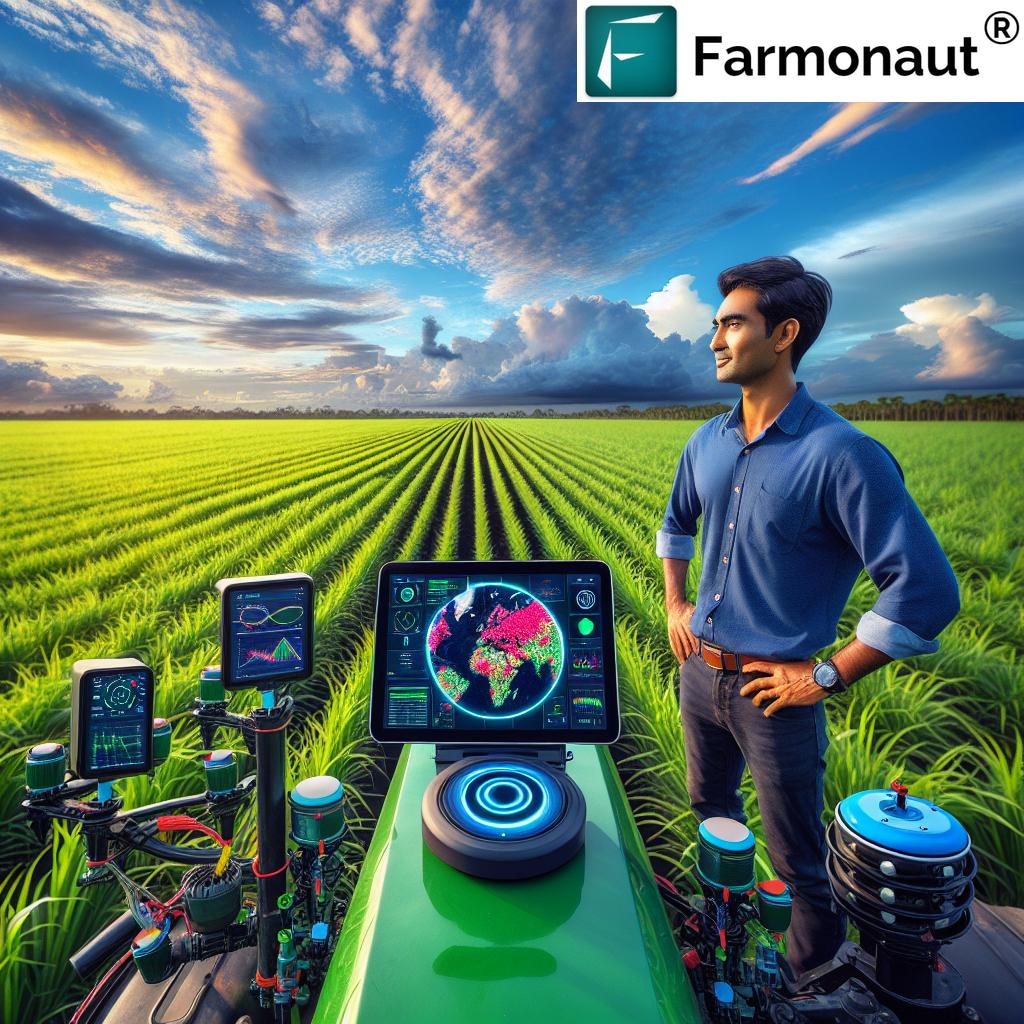
“Farmonaut’s precision agriculture technology can improve crop yield predictions by up to 30% through satellite monitoring and soil analysis.”
Welcome to our weekly blog post, where we delve into the cutting-edge world of sustainable farming practices and how Farmonaut’s precision agriculture technology is revolutionizing the agricultural landscape in Queensland and beyond. As the sun rises over the vast expanses of the Sunshine Coast and illuminates the fertile fields of the Gold Coast hinterland, a new era of farming is dawning – one that promises to transform the way we cultivate our land and nourish our communities.
In this comprehensive exploration, we’ll journey through the innovative digital agriculture solutions that are reshaping the future of farming. From the coastal plains of Hervey Bay to the rolling hills of Toowoomba, farmers are embracing technologies that not only boost productivity but also champion environmental stewardship. Join us as we uncover how Farmonaut’s advanced tools are empowering farmers across the state to make data-driven decisions that enhance crop yields while preserving our precious natural resources.
The Digital Revolution in Queensland’s Agriculture
As we witness the transformation of traditional farming methods, it’s clear that the agricultural sector in Queensland is undergoing a significant shift. The integration of precision agriculture technology is not just a trend; it’s a necessity in the face of climate change, resource scarcity, and the growing demand for sustainable food production. Farmonaut stands at the forefront of this revolution, offering a suite of tools that are as diverse as the landscapes of our great state.
From the sugar cane fields of Bundaberg to the fruit orchards of Stanthorpe, farmers are turning to satellite crop monitoring and remote sensing in agriculture to gain unprecedented insights into their land. These technologies allow for a level of precision that was once unimaginable, enabling farmers to monitor crop health, soil moisture, and even predict yields with remarkable accuracy.
Satellite Crop Monitoring: A Bird’s Eye View of Agricultural Health
One of the cornerstones of Farmonaut’s precision agriculture technology is satellite crop monitoring. This innovative approach provides farmers with a comprehensive overview of their fields, offering real-time data that can inform crucial decisions throughout the growing season. Let’s explore how this technology is making waves from the Capricorn Coast to the Darling Downs:
- Real-time vegetation health analysis: Using advanced NDVI (Normalized Difference Vegetation Index) metrics, farmers can assess crop vigor and identify areas of stress before they become visible to the naked eye.
- Soil moisture mapping: By analyzing multispectral imagery, Farmonaut’s technology can create detailed soil moisture maps, helping farmers optimize irrigation schedules and conserve water.
- Early pest and disease detection: Subtle changes in crop reflectance can indicate the onset of pests or diseases, allowing for targeted interventions that minimize chemical use and maximize crop protection.
This level of insight is particularly valuable in a state as vast and varied as Queensland, where conditions can change dramatically from the tropical north to the temperate south. By harnessing the power of satellite technology, we’re enabling farmers to manage their land with precision, regardless of its location or size.
Remote Sensing in Agriculture: Beyond the Visible Spectrum
Remote sensing technology is another critical component of Farmonaut’s precision agriculture arsenal. By capturing data across various spectral bands, remote sensing provides insights that go far beyond what the human eye can perceive. Here’s how this technology is benefiting Queensland’s diverse agricultural sectors:
- Crop type identification: Remote sensing can distinguish between different crop types, aiding in land use planning and crop rotation strategies.
- Yield estimation: By analyzing crop density and health over time, farmers can make more accurate yield predictions, informing harvest planning and market strategies.
- Nutrient management: Spectral analysis can reveal nutrient deficiencies in crops, allowing for targeted fertilizer application that reduces waste and environmental impact.
From the cotton fields of the Border Rivers region to the tropical fruit plantations of the Wet Tropics, remote sensing is providing Queensland farmers with the data they need to make informed decisions that boost productivity while minimizing environmental impact.
Smart Irrigation Systems: Conserving Queensland’s Precious Water Resources
In a state where water is often scarce and droughts are a recurring challenge, smart irrigation systems are a game-changer. Farmonaut’s precision agriculture technology includes advanced irrigation management tools that are helping farmers across Queensland to use water more efficiently:
- Soil moisture sensors: These devices provide real-time data on soil water content, allowing for precise irrigation scheduling.
- Weather-based irrigation control: By integrating local weather forecasts, irrigation systems can adjust watering schedules to avoid waste and maximize efficiency.
- Drip irrigation optimization: Smart systems can control drip irrigation networks, ensuring that each plant receives exactly the amount of water it needs.
From the dry inland regions of the Central West to the more humid coastal areas of the Sunshine Coast, these smart irrigation systems are helping farmers to conserve water while maintaining optimal crop health.
“Sustainable farming practices using smart irrigation systems can reduce water usage by 20-40% while maintaining or improving crop yields.”
Soil Health Analysis: The Foundation of Sustainable Agriculture
At the heart of any successful farming operation is healthy soil. Farmonaut’s soil health analysis tools are providing Queensland farmers with detailed insights into the very foundation of their crops:
- Nutrient mapping: By analyzing soil samples and correlating them with satellite data, farmers can create precise nutrient maps of their fields.
- pH level monitoring: Regular soil pH assessments help farmers maintain optimal growing conditions for their crops.
- Organic matter content: Tracking organic matter levels over time allows farmers to improve soil structure and water retention capabilities.
These soil health insights are particularly valuable in regions like the Darling Downs, where rich agricultural soils are a precious resource that must be carefully managed for long-term sustainability.
Explore Farmonaut’s API for advanced agricultural data integration
Crop Yield Prediction: Data-Driven Decision Making
One of the most powerful features of Farmonaut’s precision agriculture technology is its ability to predict crop yields with unprecedented accuracy. This capability is transforming farm management across Queensland:
- Historical data analysis: By examining years of crop performance data, the system can identify trends and patterns that inform future planting decisions.
- Real-time growth monitoring: Continuous satellite monitoring allows for up-to-date yield forecasts throughout the growing season.
- Weather impact assessment: The system integrates weather forecasts to adjust yield predictions based on expected conditions.
For farmers in regions like the Wide Bay-Burnett, where diverse crops from sugar cane to macadamias are grown, accurate yield predictions are essential for planning harvests, managing labor, and negotiating contracts with buyers.
Agricultural Drone Applications: A New Perspective on Farming
While satellite technology provides broad coverage, agricultural drones offer a more detailed, on-demand view of farm conditions. Farmonaut’s integration of drone technology is opening up new possibilities for Queensland farmers:
- High-resolution imaging: Drones can capture detailed images of crops, allowing for the identification of issues at the individual plant level.
- Precision spraying: Equipped with spray nozzles, drones can apply pesticides or fertilizers with pinpoint accuracy, reducing chemical use and environmental impact.
- 3D mapping: Drone-generated 3D maps help farmers understand field topography and water flow, informing decisions on drainage and erosion control.
From the vast cattle stations of the Gulf Country to the intensive horticultural operations of the Lockyer Valley, drones are providing farmers with a new tool to monitor and manage their land more effectively.
Farm Management Software: The Digital Command Center
Tying all these technologies together is Farmonaut’s comprehensive farm management software. This digital platform serves as a central hub for all farm operations, offering:
- Data integration: Bringing together satellite imagery, drone footage, soil sensor data, and weather information into a single, user-friendly interface.
- Task management: Allowing farmers to schedule and track all farm activities, from planting to harvesting.
- Record keeping: Maintaining detailed records of inputs, yields, and financial data for better long-term planning and compliance.
For farmers managing properties across Queensland’s diverse landscapes, from the Channel Country to the Atherton Tablelands, this software provides the tools needed to make informed decisions and optimize operations across vast and varied territories.
Environmental Stewardship Through Technology
As we embrace these advanced technologies, it’s crucial to remember that the ultimate goal is not just increased productivity, but also enhanced environmental stewardship. Farmonaut’s precision agriculture technology is helping Queensland farmers to:
- Reduce chemical use: By targeting inputs more precisely, farmers can minimize the application of pesticides and fertilizers, protecting local ecosystems.
- Conserve water: Smart irrigation systems help preserve Queensland’s precious water resources, ensuring sustainable use for future generations.
- Protect biodiversity: By optimizing land use, farmers can set aside areas for wildlife corridors and habitat preservation.
From the Great Barrier Reef catchments to the Murray-Darling Basin, these sustainable farming practices are helping to safeguard Queensland’s unique and diverse environments.
| Aspect | Traditional Farming | Precision Agriculture with Farmonaut |
|---|---|---|
| Resource Efficiency | Uniform application of water and inputs | Targeted resource use, up to 30% water savings |
| Crop Yield Prediction | Based on historical averages and visual inspection | 20% increase in accuracy through data-driven forecasts |
| Environmental Impact | Higher risk of over-application of chemicals | Reduced chemical use by up to 40% through precision application |
| Decision Making | Often intuition-based or reactive | Data-driven, proactive management |
| Technology Integration | Limited use of digital tools | Comprehensive integration of satellite, drone, and IoT technologies |
The Future of Farming in Queensland
As we look to the future, it’s clear that precision agriculture technology will play an increasingly vital role in Queensland’s agricultural sector. Farmonaut’s innovative solutions are not just improving farm productivity; they’re helping to create a more resilient and sustainable food system for our state.
From the coastal plains of Mackay to the fertile soils of the Darling Downs, farmers are embracing these technologies to meet the challenges of a changing climate and growing global demand for food. By making data-driven decisions, they’re not only improving their own operations but also contributing to the broader goals of environmental conservation and food security.
Embracing Innovation for a Sustainable Future
As we conclude our exploration of Farmonaut’s precision agriculture technology and its impact on Queensland’s farming practices, it’s clear that we’re standing at the threshold of a new agricultural era. The integration of satellite crop monitoring, remote sensing, smart irrigation systems, and advanced farm management software is not just enhancing productivity; it’s fundamentally changing how we approach farming in our diverse and challenging landscapes.
From the sugar cane fields of Bundaberg to the cattle stations of the Gulf Country, farmers are harnessing the power of data to make informed decisions that benefit both their bottom line and the environment. By embracing these innovative technologies, Queensland’s agricultural sector is positioning itself as a leader in sustainable farming practices, ready to meet the challenges of the 21st century and beyond.
As we look to the future, let’s continue to support and invest in these technologies that promise a more resilient, productive, and environmentally friendly agricultural sector. Together, we can ensure that Queensland remains at the forefront of sustainable farming, setting an example for the rest of Australia and the world.
FAQ: Precision Agriculture Technology in Queensland
Q: How does satellite crop monitoring benefit Queensland farmers?
A: Satellite crop monitoring provides real-time data on crop health, soil moisture, and potential issues, allowing farmers to make timely decisions and optimize resource use across Queensland’s diverse agricultural regions.
Q: Can precision agriculture technology help with water conservation in drought-prone areas?
A: Yes, smart irrigation systems and soil moisture sensors can significantly reduce water usage by up to 40% while maintaining or improving crop yields, which is crucial in Queensland’s drought-prone areas.
Q: How does Farmonaut’s technology adapt to Queensland’s varied climate zones?
A: Farmonaut’s precision agriculture technology integrates local weather data and historical patterns to provide customized recommendations for each of Queensland’s unique climate zones, from tropical north to temperate south.
Q: What role do agricultural drones play in precision farming?
A: Agricultural drones offer high-resolution imaging and precise application of inputs, allowing for targeted management of crops across Queensland’s vast and varied landscapes.
Q: How can farmers in remote areas of Queensland access and benefit from this technology?
A: Farmonaut’s cloud-based platform and mobile apps allow farmers in even the most remote areas of Queensland to access vital agricultural data and insights, as long as they have internet connectivity.
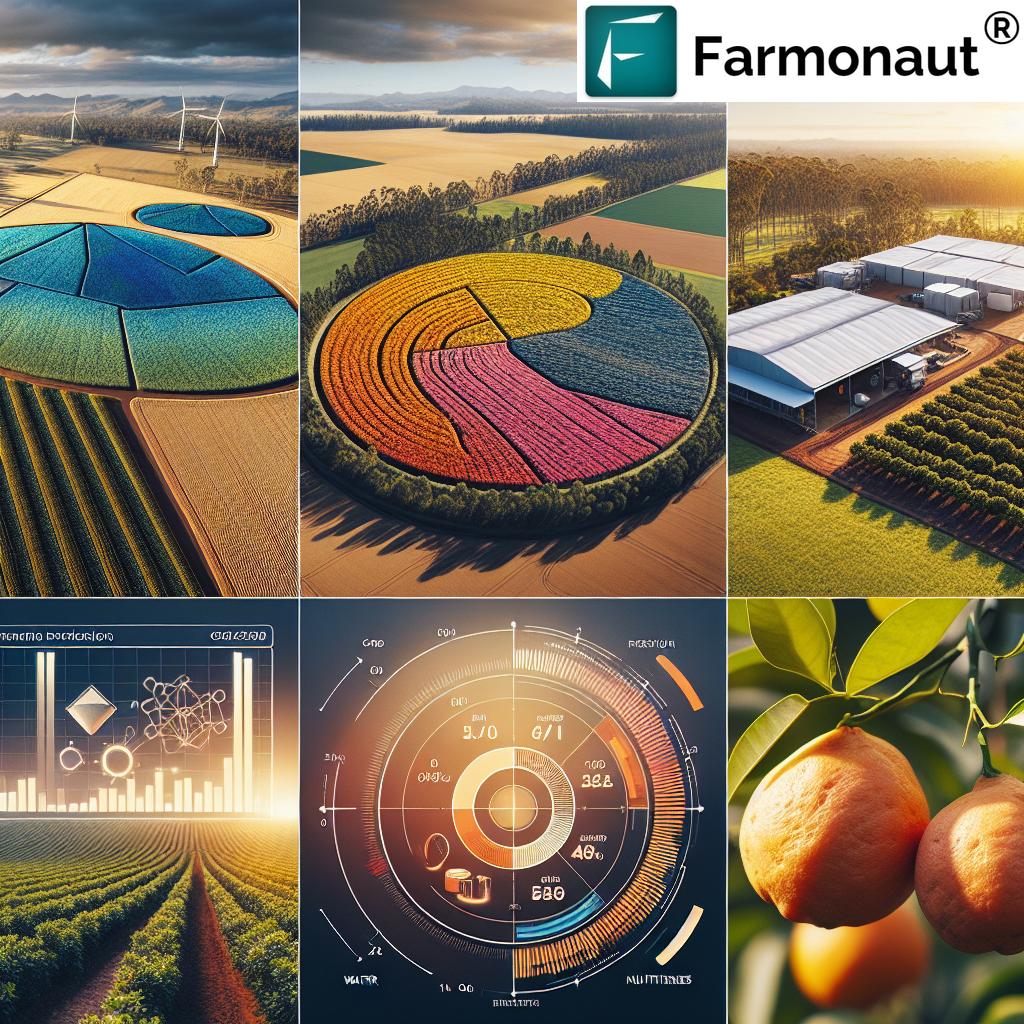
Access Farmonaut’s API Developer Docs for advanced integration
As we wrap up this week’s exploration of sustainable farming practices and Farmonaut’s precision agriculture technology, we invite you to join us in embracing the digital revolution that’s transforming Queensland’s agricultural landscape. Whether you’re a farmer in the Lockyer Valley, a grazier in the Central West, or an agribusiness professional in Brisbane, the tools and insights provided by Farmonaut can help you optimize your operations, conserve resources, and contribute to a more sustainable future for our state.
Stay tuned for our next weekly installment, where we’ll continue to bring you the latest news and innovations in agriculture from across Queensland and beyond. From the coastal plains of the Gold Coast to the rich soils of the Darling Downs, we’re committed to supporting our farmers and showcasing the incredible advancements that are shaping the future of food production in our great state.
Remember, the future of farming is here, and it’s digital, data-driven, and more sustainable than ever before. By embracing precision agriculture technology, we’re not just improving our farms – we’re nurturing the very land that sustains us, ensuring a bountiful harvest for generations to come. Join us in this exciting journey towards a smarter, more sustainable agricultural future for Queensland and beyond.





